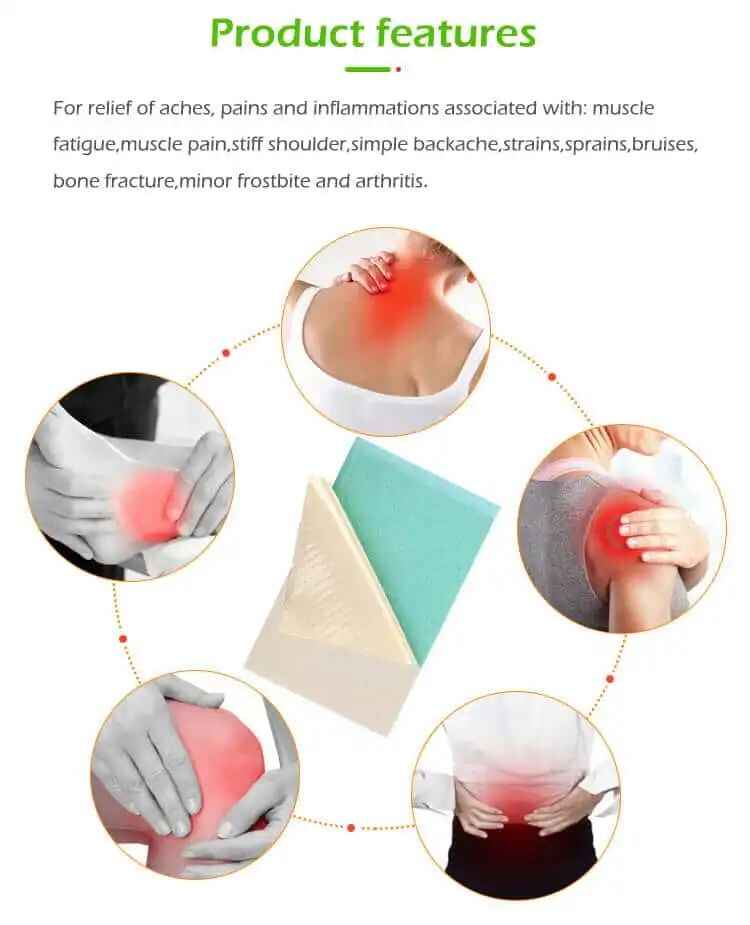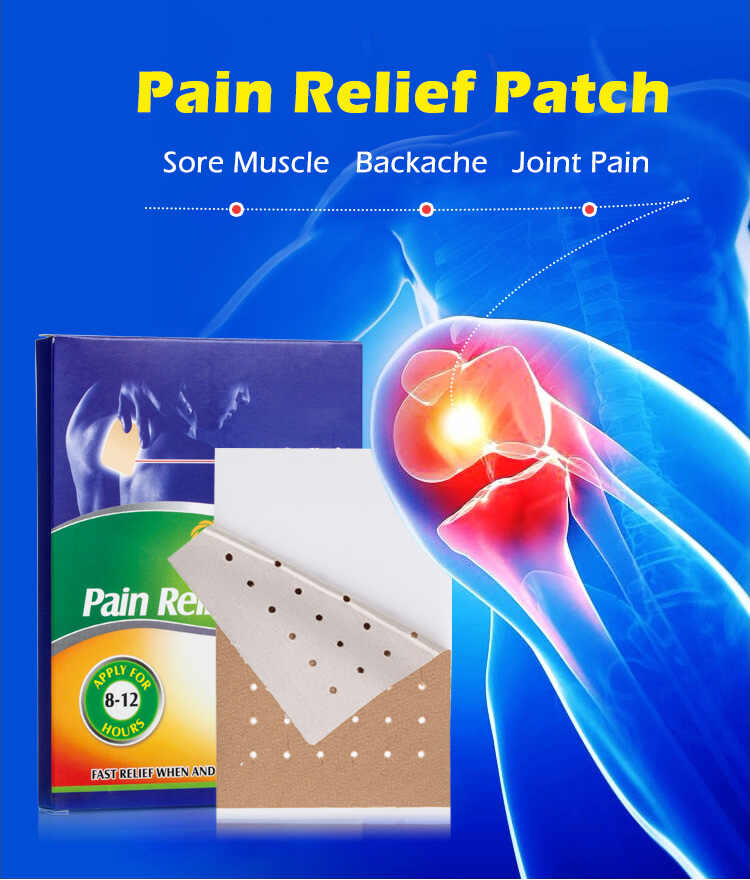What Ingredients Are Commonly Used in Custom Heat Therapy Patches?
Custom Heat Therapy Patches are a popular choice for pain relief, offering targeted warmth that can help alleviate discomfort caused by muscle aches, joint pain, and stiffness. These patches are commonly used in a variety of therapeutic applications, ranging from sports recovery to chronic pain management. However, to effectively serve their purpose, the ingredients used in Custom Heat Therapy Patches play a crucial role. Whether you're working with a Heat Therapy Patch Manufacturer, an OEM, or a Heat Therapy Patch Supplier, understanding the ingredients is essential for creating a safe, effective, and comfortable product. In this article, we will dive into the commonly used ingredients in Heat Therapy Patches, exploring their functions and benefits.

1. The Role of Ingredients in Custom Heat Therapy Patches
Custom Heat Therapy Patches are designed to provide pain relief through the application of controlled heat. The key to their effectiveness lies in the ingredients used to generate and maintain that heat. These ingredients can also contribute to the overall comfort and skin compatibility of the patch, ensuring that it remains comfortable for the user during extended use.
Typically, Heat Therapy Patch Manufacturers or OEMs will formulate patches using a combination of natural and synthetic ingredients to achieve the desired therapeutic effect. While each brand and manufacturer may offer unique formulations, the following ingredients are most commonly found in Custom Heat Therapy Patches.
2. Common Ingredients in Heat Therapy Patches
a) Iron Powder
Iron powder is one of the most widely used ingredients in Heat Therapy Patches. When exposed to air, iron undergoes an exothermic reaction, releasing heat. This process is safe, effective, and long-lasting, making iron-based patches an ideal solution for Custom Heat Therapy Patches.
How it works: Iron powder is combined with other ingredients such as salt, water, and activated carbon. When air enters the patch, the iron reacts and produces heat, which can last for several hours.
Benefits: Iron powder is inexpensive, reliable, and provides consistent heat over a prolonged period. It’s also a non-toxic and natural ingredient, making it suitable for people with sensitive skin.
b) Activated Carbon
Activated carbon is often used in Heat Therapy Patch OEM formulations to help regulate heat output. It plays a critical role in managing the chemical reactions that generate heat in the patch, ensuring the temperature is controlled and safe for skin contact.
How it works: Activated carbon helps to balance the exothermic reaction between iron and oxygen, ensuring a steady heat release.
Benefits: The use of activated carbon contributes to a longer-lasting heat experience and helps maintain the patch’s effectiveness over time. It also enhances comfort by preventing the patch from getting too hot.
c) Sodium Chloride (Salt)
Salt, or sodium chloride, is another crucial ingredient that is commonly included in the composition of Heat Therapy Patches. Salt is typically combined with iron powder in many formulations to activate the heat-producing reaction.
How it works: Salt aids the process of oxidation by speeding up the reaction between iron and oxygen, which leads to the generation of heat.
Benefits: Salt is inexpensive and enhances the overall effectiveness of the patch. It also helps in the even distribution of heat, making the patch more comfortable to wear.
d) Water
Water is a key ingredient in many Custom Heat Therapy Patch formulations, as it is essential for initiating and sustaining the heat-producing reaction. The presence of water also ensures that the patch remains pliable and can conform comfortably to the body’s shape.
How it works: Water is combined with iron powder, salt, and activated carbon in a sealed environment within the patch. When the patch is activated, water helps to facilitate the oxidation process that produces heat.
Benefits: Water contributes to the longevity of the heat and helps prevent the patch from becoming too dry or stiff. It also ensures that the patch is gentle and easy to apply.
e) Cellulose or Non-Woven Fabric
The outer layer of the Heat Therapy Patch typically consists of cellulose or non-woven fabric, which helps to contain the heat-producing ingredients and allows for easy adhesion to the skin.
How it works: The fabric acts as a barrier that holds all the heat-producing ingredients in place while allowing for controlled heat transfer. It is also breathable, ensuring that the patch remains comfortable on the skin.
Benefits: Non-woven fabrics are soft, flexible, and provide a comfortable wearing experience. They also allow for a good level of breathability, which can prevent skin irritation.
f) Herbal Extracts and Essential Oils
In recent years, many Private Label Heat Therapy Patches have incorporated herbal extracts and essential oils into their formulations for added therapeutic benefits. These ingredients provide not only heat relief but also additional soothing effects.
Common herbal ingredients: Menthol, eucalyptus oil, camphor, and ginger extract are some of the most popular natural ingredients added to Heat Therapy Patches.
How they work: These ingredients provide a cooling or warming sensation, enhance blood circulation, and promote muscle relaxation.
Benefits: The addition of herbal extracts and essential oils can create a more holistic approach to pain relief. They can also improve the overall scent of the patch, making it more pleasant to wear.
g) Adhesive Materials
The adhesive used in Custom Heat Therapy Patches is crucial for ensuring that the patch stays securely in place for the duration of its application. High-quality adhesives are typically used to ensure that the patch can be comfortably worn without slipping or irritating the skin.
How it works: The adhesive layer allows the patch to stick to the skin without causing discomfort or leaving residue when removed.
Benefits: A good adhesive ensures that the patch remains effective throughout its use. It also prevents the patch from shifting, ensuring that the heat remains localized where it’s needed.
3. Choosing the Right Ingredients for Your Custom Heat Therapy Patch
When developing a Custom Heat Therapy Patch, choosing the right ingredients is crucial for creating a product that meets your brand’s standards and delivers the desired benefits to consumers. Here are some important considerations:
a) Target Audience
Consider the needs of your target market. For instance, if you're catering to individuals who prefer natural products, you may want to incorporate herbal extracts and essential oils. If your audience is more concerned with consistent heat and longevity, you may opt for iron powder-based patches.
b) Product Durability
If your goal is to create a long-lasting heat therapy patch, ingredients like activated carbon, iron powder, and sodium chloride are essential for ensuring that the patch delivers heat consistently for hours.
c) Skin Sensitivity
Be mindful of the ingredients used, particularly when targeting people with sensitive skin. Always ensure that the adhesive and any other components are skin-friendly and do not cause irritation. Many Heat Therapy Patch Manufacturers offer hypoallergenic options to cater to individuals with sensitive skin.
4. Benefits of Working with a Heat Therapy Patch Manufacturer or OEM
Working with a reliable Heat Therapy Patch Supplier or OEM offers numerous advantages:
Expertise: An experienced Heat Therapy Patch Manufacturer will guide you through the selection of appropriate ingredients and formulations that meet your specific needs.
Customization: With an OEM, you can create a Custom Heat Therapy Patch that suits your branding, packaging, and product specifications.
Quality Control: Partnering with a reputable OEM ensures that your patches meet high-quality standards, are safe to use, and deliver the desired results.
5. Frequently Asked Questions (FAQs)
What are the most common ingredients in Custom Heat Therapy Patches?
Common ingredients include iron powder, activated carbon, sodium chloride (salt), water, cellulose or non-woven fabric, and sometimes herbal extracts or essential oils.
Are Custom Heat Therapy Patches safe to use?
Yes, when created by a reputable Heat Therapy Patch Manufacturer, the ingredients used are safe for use. However, always ensure the patch is tested for safety and effectiveness.
Can I use natural ingredients like menthol or eucalyptus oil in my Custom Heat Therapy Patch?
Yes, many Private Label Heat Therapy Patches incorporate herbal extracts and essential oils like menthol or eucalyptus for added therapeutic benefits.
How long do Heat Therapy Patches stay hot?
Depending on the formulation, Heat Therapy Patches can stay warm for 6 to 12 hours, providing long-lasting relief.
What factors should I consider when choosing ingredients for my Custom Heat Therapy Patch?
Consider your target audience’s preferences, skin sensitivity, the desired duration of heat, and the effectiveness of the ingredients in delivering relief.
Conclusion
Creating a Custom Heat Therapy Patch involves choosing the right combination of ingredients to deliver consistent, effective, and safe pain relief. Whether you’re partnering with a Heat Therapy Patch Manufacturer, an OEM, or a Heat Therapy Patch Supplier, understanding the role of each ingredient is crucial in crafting a product that resonates with consumers. By selecting ingredients that suit your brand and customer needs—whether it’s for extended heat, skin comfort, or natural healing—you can create a Private Label Heat Therapy Patch that stands out in the marketplace.






